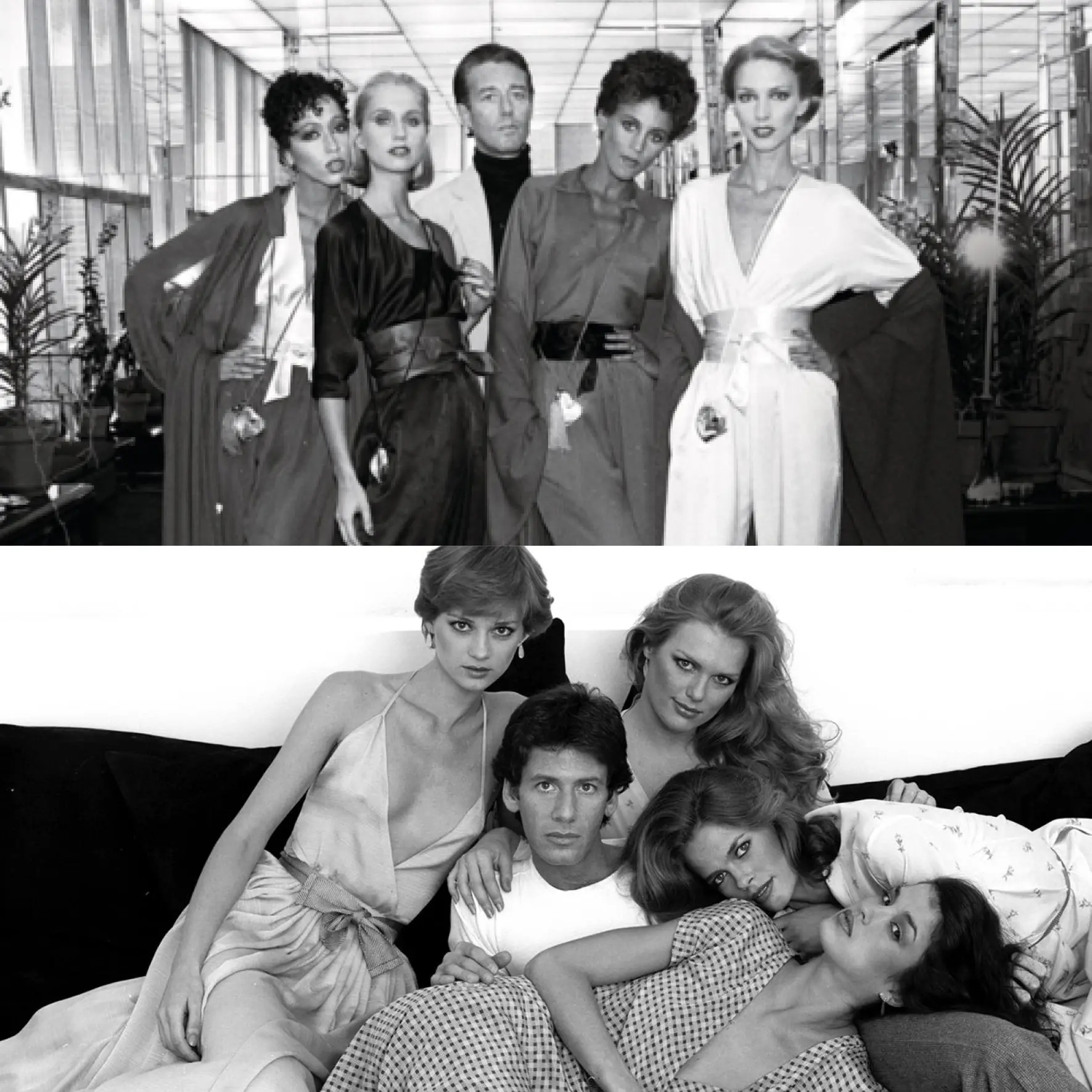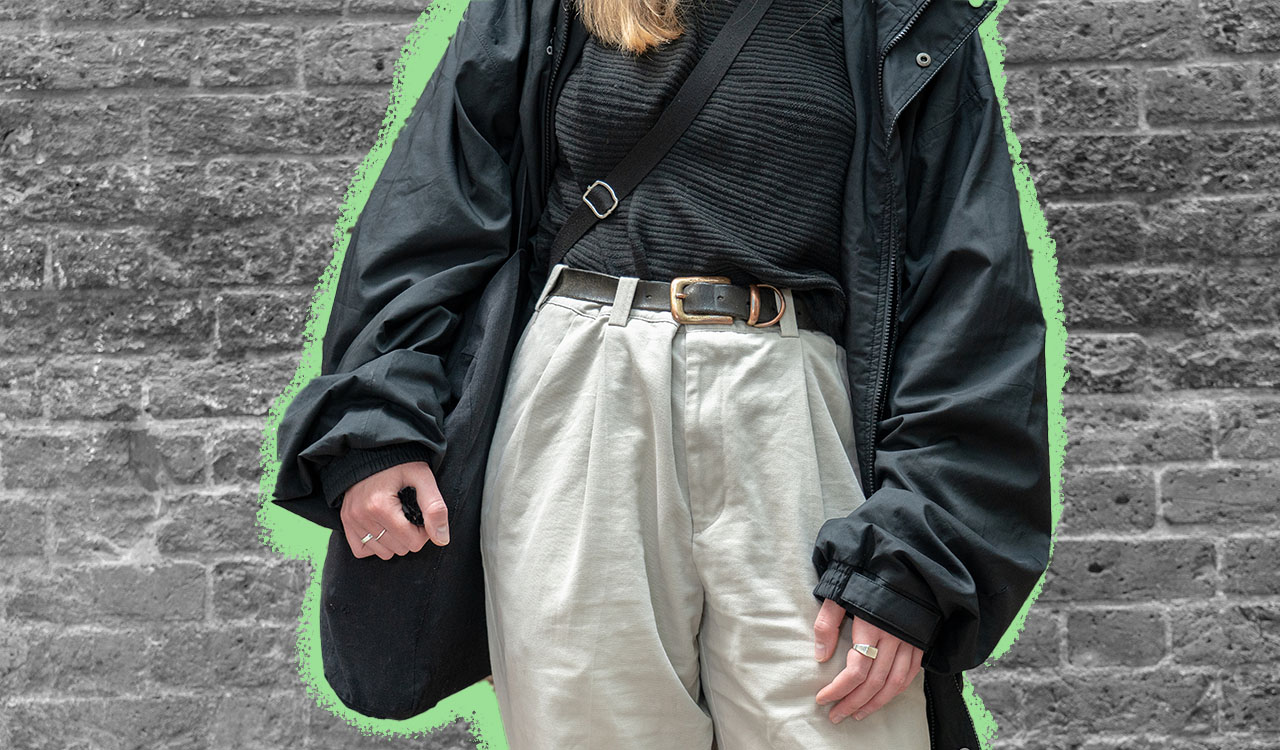Roy Halston Frowick established his own look, introduced a spectacular new fabric, and reinvented functional glamour. During the 1970s he was right at the very top of American designers. Halston’s ideas were original, sensual, and wearable. His elongated silhouettes skimmed the body, capturing a sophistication that was just as at home at an elegant black-tie dinner or a disco.
Fluid and Sensual
Halston told me the “the natural flow of fabrics allows the body to create its own shape.” This set him apart from virtually all the other big-time designers. Halston’s designs were simple, unconstructed, and principally made in solid colors. “I hate things that don’t work. Bows that don’t tie, buttons that don’t button, zippers that don’t zip, wrap dresses that don’t wrap,” he said. Elsa Peretti, a close friend of Halston and the most acclaimed jewelry designer of the day, said, “He is a workaholic who would stay up all night cutting. He was an incredible cutter. I loved to watch him.”
Central Casting
Halston had a really glamorous quality about him. He was tall and very handsome. He always wore aviator sunglasses inside and outdoors, day and night. He was attracted to sophisticated celebrities and loved discos, especially Studio 54. He was a star, if not the star, of Studio 54. He could be found there with Liza Minnelli, Elizabeth Taylor, Bianca Jagger, Andy Warhol, and his on-again, off-again boyfriend, Victor Hugo. Victor was a Venezuelan artist and a sometime window dresser. He was good looking, charming, lively, and a superstar in the gay culture of the day. It is said his name, Hugo, is a reference to his physical endowment. Halston was a grand, ultra-chic designer who lived with an ultra-low life.
Party Boy
Halston loved to throw large parties at his spectacular townhouse on Manhattan’s Upper East Side where he lived with Victor. I attended some of those parties, where fifty to a hundred or so guests were treated to Champagne and the hot drugs of the day. The parties went well into the night and many attendees, including Halston, went onto Studio 54 in the wee hours of the morning.
The townhouse at 101 East 63rd Street was nondescript from the outside. Inside it had a clean and simple design, with dramatic touches. Paul Randolph, the architect who designed the interior, said, “I wanted Halston to have a world of his own. A retreat from city life.” The townhouse opened into a three-story tall salon, where he held his parties. Along one wall was a staircase without a railing that climbed three floors to a guest bedroom. It’s a miracle with all the Champagne and drugs consumed there that no one fell off those vertigo-inducing stairs. When guests came for small dinners, the meal consisted of caviar, a baked potato, and cocaine. Some guests were said to have skipped the baked potato.
Hat Tricks
Halston was born in Des Moines, Iowa, to a middle-class family. His father was an accountant. He became interested in sewing from watching his mother, who was a seamstress. His early fashion interests were designing and making hats. As a seven-year-old, he was fascinated by his grandmother’s hats. He left college after one semester and moved to Chicago where he started designing hats that he sold in a local hair salon.
Then the stars aligned for him. He moved to New York where he became a hat designer for Bergdorf Goodman. It was at that time that Halston made the pillbox that Jackie Kennedy wore to her husband’s inauguration. It became the most famous hat in the world.
Transitions
As the1960s progressed, most women stopped wearing hats. Halston left Bergdorf’s and began designing clothes. He was financed with a $120,000 investment by Texas millionaire, Estelle Marsh from Amarillo. She was a local philanthropist and not particularly stylish. Halston, according to some of his close friends, said he referred to her as Mrs. Marshmallow.
He launched his ready-to-wear collection in 1969 and opened a boutique on Madison Avenue. His simple, fresh look made him an overnight star. His early, body-clinging designs were, for the most part, made of silk and cashmere. Then he discovered a fabric called Ultrasuede, a microfiber invented by a Japanese scientist in 1970. When Halston did his first collection using Ultrasuede, he set the luxury fashion world on fire. In 1972, for example, he sold 80,000 Ultrasuede shirtwaist dresses. I said at the time that he just copied his previous collection, only changing the fabric. Since he was known for his hats at Bergdorf’s and had a large celebrity clientele, when he became a full-fledged fashion designer, he was able to bring his hat customers along and they loved his fashions.
Show Stoppers
Halston loved a big show. He was always surrounded by celebrity friends whenever he went out. He took a dozen or more models on extravagant trips to U.S. and foreign cities, making big splashes. He called his group of models his “Halstonettes.” He dressed them all not only for fashion presentations but for their airline flights, lunches, and dinners. They made a huge spectacle as they walked through airports or entered restaurants.
He was a master at public relations. One of his spectacular trips with twelve of his Halstonettes was three days in Acapulco. He not only showed his fashions, but also paraded his entourage to the most popular spots for lunches, dinners, and discos. The Halstonettes were dressed in new outfits for each public appearance.
In 1979 he got together a dozen models, led by Anjelica Huston, Karen Bjornsen, and Pat Cleveland. They embarked on a world tour starting in Los Angeles, then on to Tokyo, Beijing, Shanghai, and Paris. Halston said, “I designed everything they wore except what they slept in.” Pat Cleveland noted, “We were like migrating birds, well-choreographed and all color coordinated.”
Business Sense
Unlike most of the great designers, Halston did not have a business partner, like Saint Laurent had Pierre Berge, Valentino had Giancarlo Giammetti, Donna Karen had Tomio Taki, and Calvin Klein had Barry Schwartz. He was a lone wolf who made all his own business decisions.
His design house was bought by Norton Simon for an estimated $16 million in 1973. That was an unheard of sum for its time. The company, under its new owner, licensed more than thirty products over the next decade. Many of these licenses were aimed at a much lower demographic than his ready-to-wear, and his brand image began to suffer.
I was having lunch with him at his palatial office/studio in 1983, the year he signed a mega JCPenney’s deal. Talk about living over the top! He had two chefs cooking several dishes for just the two of us. He couldn’t make up his mind what he wanted to eat. It was obvious he was on some drug, as a lot of what he said didn’t make sense. He kept saying, “At JCPenney, we talk only in billions. I expect to make a billion dollars this year.”
The JCPenney deal destroyed his ready-to-wear business. Bergdorf Goodman dropped his line because it cheapened his image. With his thirty-some licenses for Halston products, most of which were lower end, the JCPenney deal was the last straw. The Halston III line for Penney’s was poorly received and discontinued. Norton Simon sold the Halston Company in 1983 to Esmark Inc. While Norton Simon gave Halston control over the creative side of the company, that was not the case with Esmark. Halston spent the next several years trying to get his name back.
End Game
His life was a duality and he was a man of contradictions. Halston became a fashion-design superstar almost overnight. He was sometimes standoffish and very grand, and at other times very friendly and charming. The end for Halston couldn’t have been more sad. He was diagnosed with AIDS in 1988 and died in 1990 at the age of fifty-seven.
Calvin Klein
So much that is written and talked about Calvin Klein focuses on his personal life and brilliant marketing. He did a couple of stints in rehab for drugs and alcohol, had two marriages to women, and had numerous relationships with men. In fact, Calvin’s good looks, charm, colorful bisexual lifestyle, and touch of bad-boy persona often overshadowed his enormous contribution to fashion as a very talented designer.
Bronx Beginnings
Born in the Bronx, his earliest interests in fashion were nurtured by his grandmother, Molly, and his mother, Flore. His grandmother once worked for Hattie Carnegie, one of the first big-name designers in the United States. Calvin’s grandmother owned a small dressmaking shop and his mother loved to sketch and talk about clothes.
In April 1968, Barry Schwartz’s small grocery store in the Bronx was destroyed in a riot the night Martin Luther King was killed. Barry was Calvin’s oldest friend, the two having played together since they were five years old. Barry had owned the store since his father was shot to death. He gave up the grocery business and used what money he had to fund Calvin Klein Inc. Schwartz became Calvin’s full-time partner and ran the business side of the company.
Shortly thereafter, Calvin had a chance encounter with Bonwit Teller’s merchandise manager. The Bonwit executive was at the York Hotel, where some designers had their showrooms, to see another designer. He got off on the wrong floor and Calvin spotted him and led him to his one-room space. Finding the clothes interesting, he asked Calvin to bring them to the store to show Mildred Custin who was Bonwit’s CEO and known for her highly evolved fashion sense. Bonwit’s, located on Fifth Avenue, was one of the leading luxury department stores of the time.
Calvin placed some of his coats and dresses on a rolling rack in his hotel room. He then pushed it a mile and a half to the store on Fifth Avenue. Custin liked Calvin’s designs and bought them on the spot. The clothes quickly sold out at Bonwit’s, the store gave Calvin a $50,000 order, and he was off and running!
The Calvin Klein Aesthetic
Calvin’s design sensibilities echoed Saint Laurent’s to some degree, with a little bit of Jill Sander thrown in. Since Italy and Paris showed their collections before New York, he was sometimes accused of being overly influenced by European designers.
Calvin inherently believed in simplicity. His color palette was restrained and limited. He believed, “Women’s clothes should be more streamlined.” He intuitively understood the changes taking place in American society and his designs reflect the fashion requirements of this cultural metamorphosis.
While coats were a large part of his earliest collections, he changed directions in 1973 to luxury sportswear. It was an instant hit. That year, he became the youngest designer to win a Coty American Fashion Critics Award. He followed it up with two more wins in 1974 and 1975. Calvin’s clean-cut simplicity was right on target.
Night Owl
A workaholic and perfectionist with incredible stamina, he was also a regular on the New York nightlife scene with a focus on Studio 54. Studio, as it was referred to by the late-night stars of the day, was a nightclub the likes of which haven’t been seen before or since. Studio could handle a fairly large crowd, and you didn’t have to be a celebrity to get in. If you looked like you might be a hot, fun person at the door, Steve Rubel, one of the co-owners, who often manned the rope, would let you in.
Studio 54 didn’t hit its stride until long after midnight. Many nights Calvin would have his friends, including Barry Diller and David Geffen, over to his apartment around midnight and then later all would go to Studio. Ian Schrager, who was the co-founder of Studio 54 with Rubel said, “There are two cultural events that people still remember, Woodstock and Studio 54.”
The scene included celebrity regulars such as Elizabeth Taylor, Cher, Liza Minnelli, Truman Capote, Halston, and Bianca Jagger. Bianca rode in on a white horse one night to celebrate her birthday. Some of the biggest stars of the day were fashion designers. Karl Lagerfeld, Valentino, and Yves Saint Laurent were among the Studio guests when they were in New York. Drugs were used openly, and sexual acts took place in restrooms and dark corners.
Calvin told me, “Studio 54 is our El Morocco, our Stork Club.” One night, a man approached Calvin around four in the morning at Studio and asked him, “How would you like to make a million dollars? I have a friend who would like to get into the jeans business and would like to use your name.”
Calvin took his name and number. Calvin, as always, even if he didn’t go to bed, was at work at 7:30 AM. He was getting ready to fly to Europe, so he told Barry about the message from the guy at Studio and asked Schwartz to call. Barry found out the number was for Puritan Fashions and hooked up with Carl Rosen, its owner. They agreed to produce a line of jeans designed by Calvin, under his brand, but manufactured and owned by Puritan. Calvin Klein Inc. received a significant royalty on each pair of jeans sold.
He was the first major designer to produce an expensive jeans line. It was the first time jeans had been seen on a designer’s runway. The upscale jeans market was more than ripe for the product. In 1976, Gloria Vanderbilt was successfully marketing a line of jeans. Two years later Calvin launched his jean line and sold 200,000 pairs of his slim-cut jeans in the first two weeks. He went on to sell millions a year for more than a decade. Six years later, Calvin Klein Inc. purchased Puritan for $70 million.
Calvin’s promotional talent was somewhat obvious in his early years, but it was his daring, advertising campaign of his jeans line that blew Madison Avenue away. His famous billboards and television ads, featuring Brooke Shields, are still talked about today as one of the greatest ad campaigns of all time, at least in the fashion world. “Jeans are sex. The tighter they are, the better they sell,” said Calvin.
Life Gets in the Way
Around this time, in 1978, Calvin had a frightening situation when the babysitter for his eleven year-old daughter, Marci, kidnapped her. Calvin paid a $100,000 ransom. The babysitter and her brother were arrested. Marci was released unharmed. Calvin, while happy with the outcome, was devastated by the experience.
Next Chapter
Calvin’s next big fashion breakthrough was men’s underwear. He literally changed the American market. During the early 1980s, John Varvatos, Calvin’s menswear designer, came up with a new underwear design that combined boxer shorts and briefs. Again, it was Calvin’s sex-related advertising concepts that drove the new, game changing product. He recruited Marky Mark, Mark Wahlberg, to pose for his underwear ad campaign. The ads were risqué and extremely controversial for their high sex quotient. Shortly after the men’s line came women’s underwear, complete with a fly front. In impressive 80,000 pairs of women’s underwear were sold in the first ninety days.
Alone in His Field
Calvin had no peer in the fashion industry for advertising genius. He immersed himself in every detail of his ad campaigns. One day I told him I was going to Phoenix and he asked me if I would take a ride about ten miles out of the city to see a billboard with his ad. He wanted to know if it was in the right location. He was always driven. As his close friend, Barry Diller, noted, “Calvin could have been successful in any business he chose to be in.”
I remember having dinner with Calvin in 1971. I had only been at WWD for a few months. He was highly energetic and over-the-top charming. His personal charm was a key to his success, and it continued throughout his career. His image and look were carefully created. His hair had obviously been cut by a master haircutter. His teeth were perfect. He wore a tee-shirt, and it was also obvious that he worked out. He mentioned the look and style of James Dean to me, and that look was clearly an inspiration for him personally.
Another dinner that comes to mind is a black-tie charity dinner that, somehow, I ended up at a table alone with Calvin and Muhammad Ali. He shook hands with Ali and made fun of Ali’s weak grip. Ali made a joking motion as if he was afraid of Calvin. It ended up being a pleasant dinner.
Another time, Calvin and I were having lunch at the restaurant 21 in New York. Toward the end of lunch he said, “You have to do me a favor. I have to go see the president of a big retailer in a few minutes, and you have to come with me.”
“Why?” I asked. He replied, “Because, otherwise, he’ll chase me around the room and try to grab me. He won’t do it if you’re with me.” We walked over to the store and into the president’s office. Sure, enough the executive went over and sat on the arm of Calvin’s chair. Calvin jumped up and the president followed him. So much for me being a shield! We had to leave. On the way out, Calvin said, “You didn’t believe me, did you?”
Footnote
While Gloria Vanderbilt and Guess Jeans played big roles in the designer jean market, it was Calvin who created the biggest buzz. He hit it out of the ballpark — way out! Calvin Klein led the way in making jeans and men’s underwear fashionable. His legacy lives on.
For more insights and gossip about the designer heydays of the 70s, check out my book, Fashion Madness, available on Amazon.




